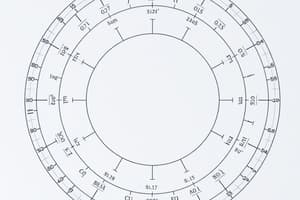Podcast
Questions and Answers
Radius of relative stiffness of cement concrete pavement is not dependent upon:
Radius of relative stiffness of cement concrete pavement is not dependent upon:
- Modulus of elasticity of cement concrete
- Poisson's ratio of concrete
- Wheel load (correct)
- Modulus of subgrade reaction
What is the formula for the radius of relative stiffness ($l$)?
What is the formula for the radius of relative stiffness ($l$)?
$l = [\frac{Eh^3}{12k(1-\mu^2)}]^{1/4}$
Flashcards are hidden until you start studying
Study Notes
Radius of Relative Stiffness in Cement Concrete Pavement
- The radius of relative stiffness (lll) is a critical factor in understanding the behavior of cement concrete pavements.
- Westergaard's formula for radius of relative stiffness is:
l=[Eh312k(1−μ2)]1/4 l = \left[\frac{Eh^3}{12k(1-\mu^2)}\right]^{1/4} l=[12k(1−μ2)Eh3]1/4 - This formula includes the following variables:
- EEE: Modulus of elasticity of cement concrete (measured in kg/cm²).
- μ\muμ: Poisson's ratio for concrete.
- hhh: Thickness of the concrete slab (measured in cm).
- kkk: Modulus of subgrade reaction (measured in kg/cm³).
Factors Dependent and Independent of Radius
- The radius of relative stiffness depends on:
- Modulus of subgrade reaction (kkk).
- Poisson's ratio of concrete (μ\muμ).
- Modulus of elasticity of cement concrete (EEE).
- The radius of relative stiffness is not dependent on:
- Wheel load; this shows that the structural response related to stiffness is not influenced by the load applied by vehicles.
Implication
- Understanding these dependencies can help in the design and analysis of pavement structures, ensuring adequate strength and stability.
Studying That Suits You
Use AI to generate personalized quizzes and flashcards to suit your learning preferences.



